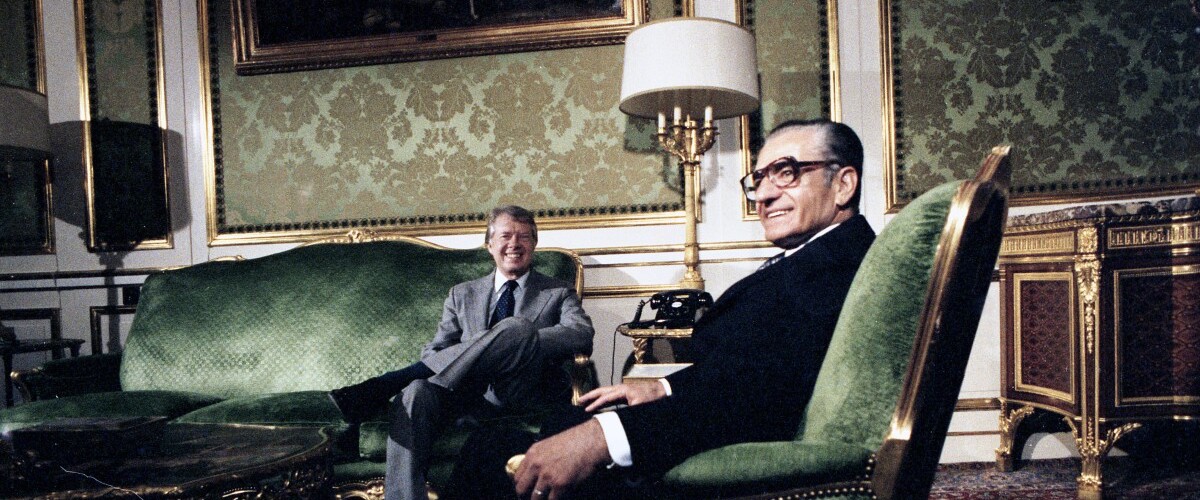As I look back at the 1979 events that set America and Iran on a still continuing course of mutual hostility and suspicion, I can almost picture my face flushed red with anger and shame. The anger came after Iranian students took over the U.S. Embassy in Tehran in November of that year, setting off a crisis that would last for 444 days. The shame resulted from sensing that the U.S. government and President Jimmy Carter were strangely impotent at overcoming these penny-ante terrorists. Why, I wondered, couldn’t Carter warn the Iranians that he would give them 24 hours’ notice (time for civilians to evacuate) before nuking one of their cities if the U.S. hostages weren’t released immediately?
I know lots of Americans at the time shared my rage and frustration. It was on the news virtually every day. Nightly reports on an ABC-TV show that became “Nightline” stoked the agonizing emotions, which only piled on the anger and shame many Americans felt when Vietnam fell only four years before. What provoked this new nightmare, which seemed to come out of nowhere?
Though, of course, it hadn’t. The crisis over the Iranians holding 53 Americans hostage was only the climactic act in a drama that had been unfolding for decades, and it’s one of the bitterest ironies of the modern era that even given all the resources and immediacy of modern media, Americans knew so little of this history in 1979, and perhaps still don’t.
That’s why Robert Stone’s two-part, four-hour documentary “Taken Hostage” (airing Nov. 14-15 on PBS, then on PBS streaming) is such a welcome corrective. It is the second of two docs about the hostage crisis to arrive on American TV this season; the first, the four-hour “Hostages,” went up on HBO in September. Both films are well worth your time. In some ways, “Hostages” offers a better, more detailed account of those painful 444 days, in part because it devotes almost all of its four hours to the subject. But as Brian Tallerico’s review of the show noted, its first hour offers only a very skimpy account of the crisis’ back story. That’s what makes the first two hours of Stone’s film so important and revelatory in comparison: It’s the best, most comprehensive and clarifying documentary I’ve seen about how U.S. actions toward Iran from the 1950s onward led to the tragedy that would embroil both countries in 1979.
The key figure early on is Iranian Prime Minister Mohammad Mosadegh, a man who was revered by many Iranians. Iran had emerged from World War II relatively unscathed, though its massive oil reserves were controlled by the British. After coming to power in 1951, Mosadegh moved to nationalize the oil industry, a change with both financial and symbolic value and one almost universally supported by Iranians. Mosadegh made history by going to the United Nations to make the case for countries like his controlling their own resources, a bold proposition that resulted in his being named Time magazine’s Man of the Year.
President Truman was sympathetic to the anti-colonial arguments of many countries including Iran. But the British were deeply unhappy over their oil rights being rescinded, and once Dwight Eisenhower became president in 1953, they found sympathetic allies in Secretary of State John Foster Dulles and his brother, CIA chief Allen Dulles. In the summer of 1953, the CIA collaborated with Britain’s MI6 on a coup that deposed Mosadegh and put all power in the hands of Iran’s young Shah, Mohammad Reza Pahlavi.
Which country led the coup? While the fascinating 2020 documentary “Coup 53” zeros in on the dirty work of the British, “Taken Hostage” says the action was initiated and directed by CIA agent Kermit Roosevelt from the basement of the U.S. Embassy. Visiting Iran, I’ve often heard the line—truth or urban myth?—that it was the perfidious Brits who coaxed their hapless Yank buddies into the overthrow, but I sometimes think this is because Iranians sense that Americans have an anti-colonial gene in their DNA while British actions in the Middle East and elsewhere were always imperialistic.
In any case, the result—which prefigured other anti-democratic coups the CIA would undertake in succeeding decades—was the overthrow not only of an idealistic prime minister but also of the one full-fledged democracy in the Middle East. Had Iran’s government been left intact, it might have served as a beacon for the entire region. But once the monarchical British rolled back their presence there, it was left to the U.S. to safeguard and support a monarch who grew increasingly tyrannical as Iran’s burgeoning oil wealth allowed him to mount ostentatious displays of his kingly power and buy billions of dollars of weaponry to shore it up.
In the 1960s, the Shah painted himself as a modernizer by staging a “White Revolution” to boost Iran’s economy with all kinds of infrastructure and development projects. He also followed his father’s lead in freeing women from the veil and encouraging their advancement in education and other arenas. Certainly, there were numerous, sometimes contradictory political and social forces roiling Iran in this era. “Taken Hostage” might be faulted from not looking into the role of the Tudeh (communist) Party in the rising anti-Shah sentiment or how America’s anti-communist fervor shaped its perception of its own interests in backing the Shah. But one thing is certain: America’s intelligence services and leaders totally missed the importance of an exiled cleric named Khomeini in the anti-Shah tide just as they missed how brittle the Shah’s hold on power was becoming.
In 1971, in the ruins of Persepolis, he mounted perhaps the most extravagant party thrown anywhere in the modern era, a celebration of 2500 years of Persian nationhood. Lavish delicacies and decorations were flown in from Paris; political leaders and celebrities from around the world were invited, and ordinary Iranians were shut out. This is often seen as the beginning of the end for Iran’s King of Kings, Light of the Aryans. In celebrating New Year’s of 1978, Jimmy Carter—whose emphasis on human right did nothing to undercut the Shah’s brutal secret police—came to Tehran to offer a toast to a monarch who would be swept from power only a year later by a violent, tumultuous revolution that enjoyed the support of the vast majority of Iranians, few suspecting they were about to trade one tyranny for another.
After leaving Iran, the Shah hopscotched through several sympathetic countries including Egypt, Morocco and Mexico. No one wanted him to stay long. When it was revealed that he had cancer and needed serious treatment, it was debated whether the U.S. should admit him. In “Taken Hostage,” Iran expert Gary Sick recalls being in a meeting with President Carter where numerous advisors all urged him to admit the Shah. Carter, whose presidency would be ruined by the hostage crisis, replied, “What will you say when they take our people hostage?”
Which of course is exactly what happened. Most Americans probably thought the Iranians were simply mad at the U.S. for harboring the man they now considered their archenemy. But the crucial truth is that they feared the U.S. was trying to restore the Shah to health so that they could reimpose him on Iran, in a repeat of the shameful 1953 coup.
There are many striking images in “Taken Hostage,” but ones that I find most touching are of Mohammad Mosadegh visiting the U.S. Besides the U.N. and the White House, he goes to Mount Vernon and to Philadelphia to see the Liberty Bell. No doubt he was captivated by America’s history and mythology and felt sure that this country birthed by our revolutionary Founders would support his ancient nation’s bid for autonomy and independence. Alas, he didn’t realize that since the late 19th century our anti-colonial inheritance was counterbalanced by a neo-imperial impulse that led us into many of the foreign entanglements our Founders warned us about. It’s a situation that has affected our relations with many countries, but perhaps none so tragically as Iran.
Premieres on PBS American Experience November 14th and 15th.




















